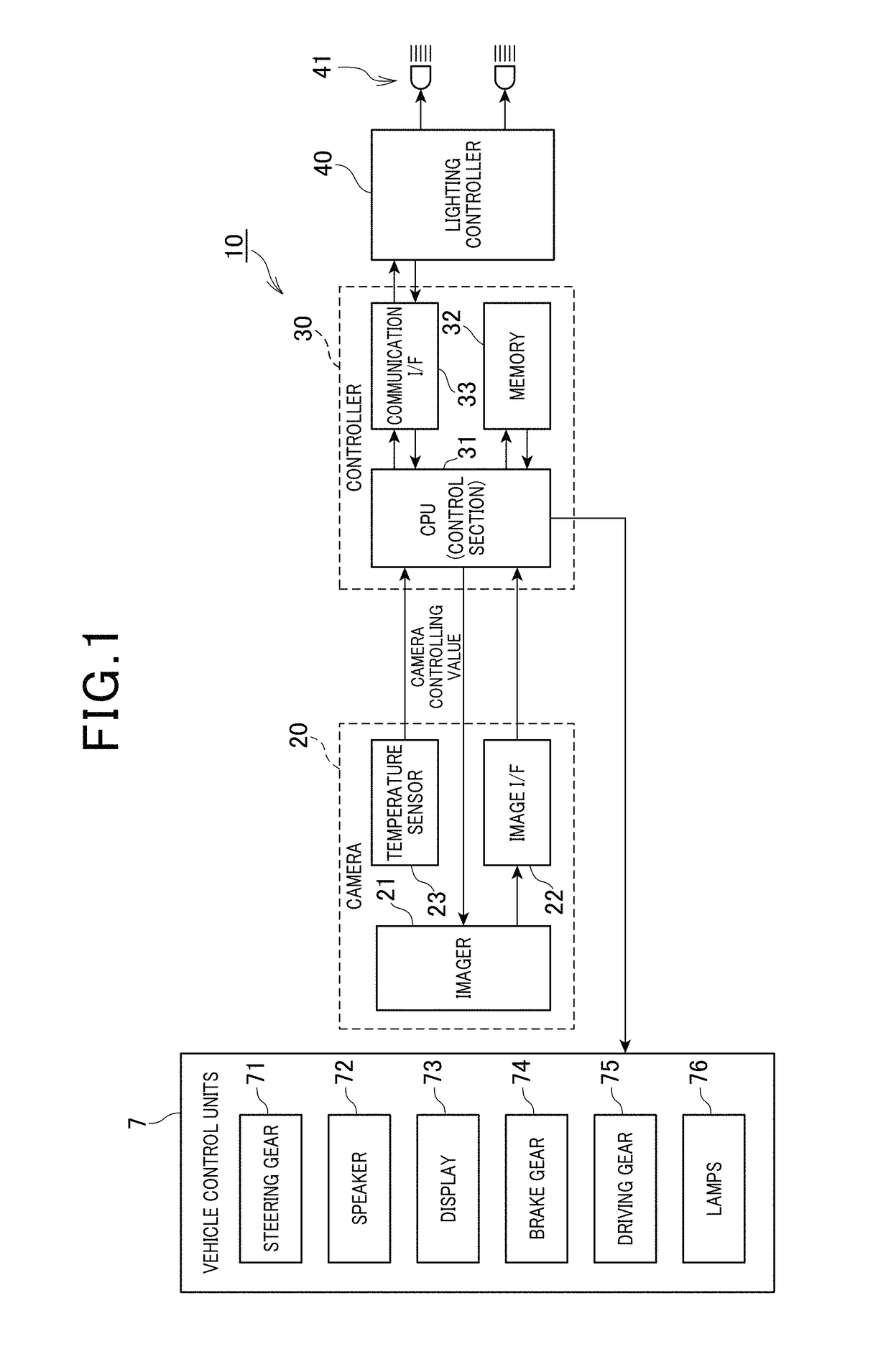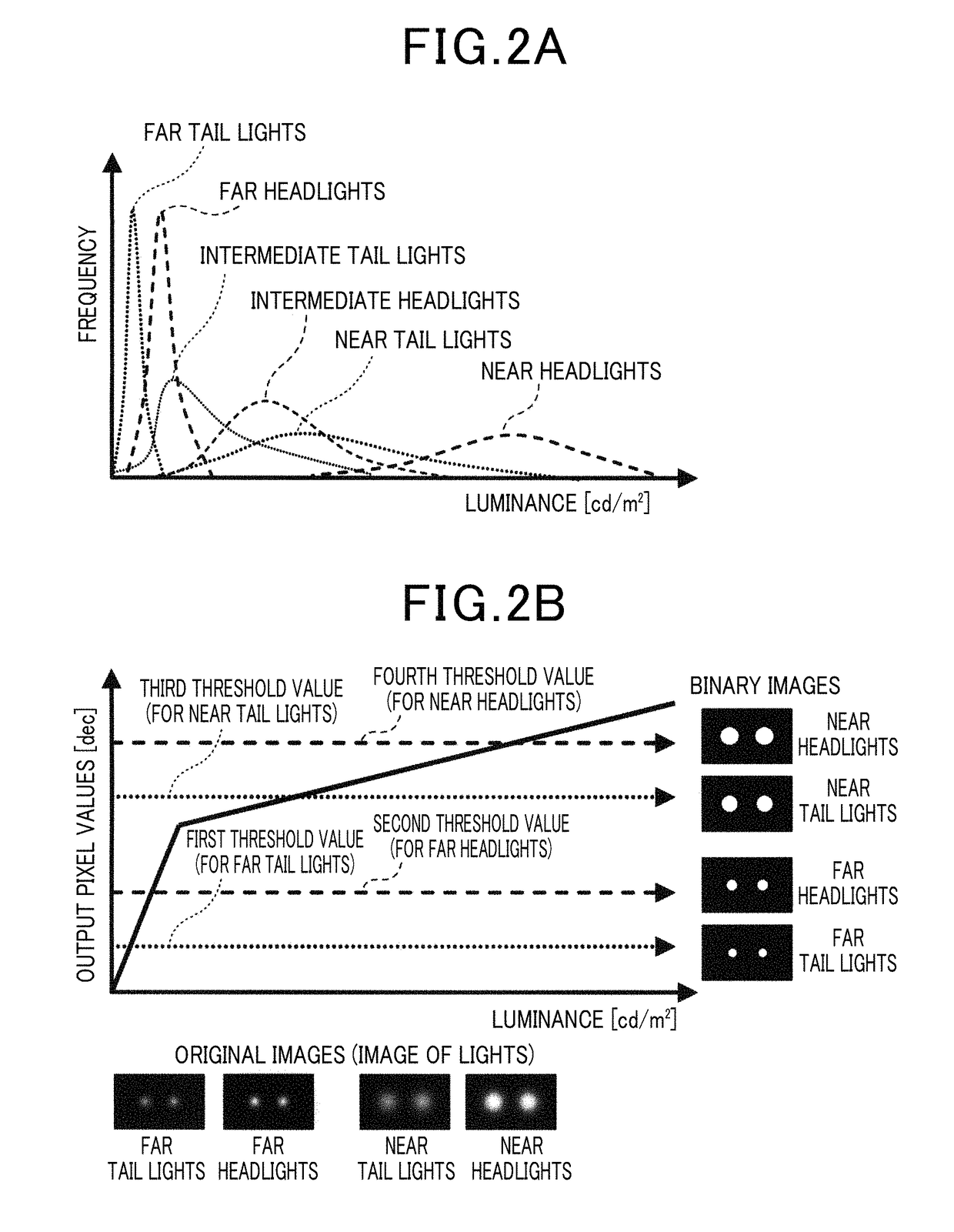Recognition object detecting apparatus
a recognition object and detecting apparatus technology, applied in the field of recognition object detecting apparatus, can solve the problems of increased processing load, reduced accuracy, and increased cost of manufacturing the apparatus, so as to increase the accuracy of detecting recognition objects and suppress processing load
- Summary
- Abstract
- Description
- Claims
- Application Information
AI Technical Summary
Benefits of technology
Problems solved by technology
Method used
Image
Examples
first embodiment
[0035][First Embodiment]
[0036](1. General Configuration)
[0037]FIG. 1 is a block diagram showing a configuration of a vehicle control system 10 of the embodiment.
[0038]The vehicle control system 10 is installed in a predetermined vehicle. The vehicle control system 10 performs auto high beam control under which the lighting state of headlights 41 of the own vehicle is changed, depending on whether or not another vehicle (leading vehicle or oncoming vehicle) is travelling ahead of the predetermined vehicle (own vehicle). While performing the auto high beam control, the lighting state of headlights 41 is automatically set to low beam if a leading vehicle or an oncoming vehicle is present and to high beam if neither a leading vehicle nor an oncoming vehicle is present.
[0039]To realize the auto high beam control described above, the headlight control system 10 includes an in-vehicle camera 20 (hereinafter, simply referred to as “camera”) which takes an image of a scene ahead of the own v...
second embodiment
[0090][Second Embodiment]
[0091]
[0092]FIG. 10 is a block diagram illustrating a general configuration of a vehicle control system 1 according to a second embodiment. The vehicle control system 1 detects various objects that are present around the vehicle. Based on the detection results and various pieces of information acquired from in-vehicle sensors 5, the vehicle control system 1 performs various vehicle controls using vehicle control units 7.
[0093]The in-vehicle sensors 5 include sensors that detect the behaviors of the vehicle, and sensors that detect the environmental features surrounding the vehicle. The sensors that detect the behaviors of the vehicle include, for example, a vehicle speed sensor, various acceleration sensors and a steering-angle sensor. The sensors that detect the environmental features surrounding the vehicle include, for example, a unit for outputting position data of the own vehicle (e.g., GPS (global positioning system)), a unit serving as a source of sup...
third embodiment
[0126][Third Embodiment]
[0127]Referring now to FIG. 16, a third embodiment is described. The third embodiment has a basic configuration similar to that of the second embodiment, with an only difference from the second embodiment being the object detection process performed by the signal processing section 120. Therefore, the following description is focused on the difference, omitting the explanation on the common configuration. Further, in the second and the subsequent embodiments, the components identical with or similar to those in the second embodiment are given the same reference numerals for the sake of omitting unnecessary explanation.
[0128]
[0129]FIG. 16 is a flow diagram illustrating an object detection process according to the third embodiment. Upon start of the present process, the signal processing section 120 performs scene estimation (step S110) and determines whether or not the estimated scene is a specific scene (step S120).
[0130]If it is determined that the estimated...
PUM
 Login to View More
Login to View More Abstract
Description
Claims
Application Information
 Login to View More
Login to View More - R&D
- Intellectual Property
- Life Sciences
- Materials
- Tech Scout
- Unparalleled Data Quality
- Higher Quality Content
- 60% Fewer Hallucinations
Browse by: Latest US Patents, China's latest patents, Technical Efficacy Thesaurus, Application Domain, Technology Topic, Popular Technical Reports.
© 2025 PatSnap. All rights reserved.Legal|Privacy policy|Modern Slavery Act Transparency Statement|Sitemap|About US| Contact US: help@patsnap.com



